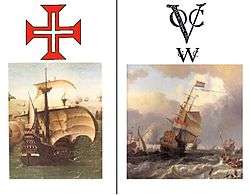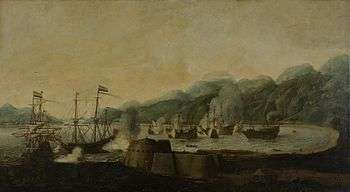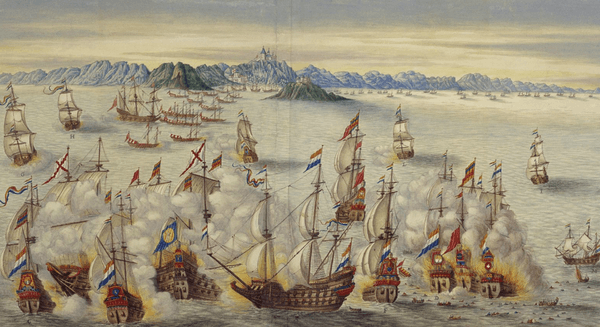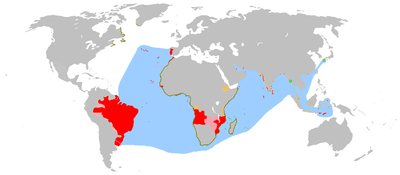Dutch–Portuguese War
| Dutch-Portuguese War | |||||||
|---|---|---|---|---|---|---|---|
 Portuguese Armada vs Chartered Fleets | |||||||
| |||||||
| Belligerents | |||||||
|
Supported by: (until 1640) Potiguara Tupis |
Supported by: (until 1640) Kingdom of Ndongo Rio Grande Tupis Nhandui Tarairiu Tribe | ||||||
| Commanders and leaders | |||||||
|
|
| ||||||
The Dutch–Portuguese War was an armed conflict involving Dutch forces, in the form of the Dutch East India Company and the Dutch West India Company, against the Portuguese Empire. Beginning in 1602, the conflict primarily involved the Dutch companies invading Portuguese colonies in the Americas, Africa, India and the Far East. The war can be thought of as an extension of the Eighty Years' War being fought in Europe at the time between Spain and the Netherlands, as Portugal was in a dynastic union with the Spanish Crown after the War of the Portuguese Succession, for most of the conflict. However, the conflict had little to do with the war in Europe and served mainly as a way for the Dutch to gain an overseas empire and control trade at the cost of the Portuguese. English forces also assisted the Dutch at certain points in the war.
The result of the war was that Portugal won in South America (Dutch Brazil) and Africa with the Recapture of Angola, and the Dutch were the victors in the Far East and South Asia. English ambitions also greatly benefited from the long-standing war between its two main rivals in the Far East.
Introduction
This war lasted from 1602 to 1663. The main antagonists were the polity of Portugal and that of the Netherlands.
Following the 1580 Iberian Union, Portugal was throughout most of the period under Habsburg rule, and the Habsburg Philip II of Spain was battling the Dutch Revolt. In his efforts to subdue the rebelling provinces, Philip II cut off the Netherlands from the spice markets of Lisbon, making it necessary for the Dutch to send their own expeditions to the sources of these commodities and to take control of the Indies spice trade.
Like the French and English, the Dutch worked to create a global trade network at the expense of the Iberian kingdoms. The Dutch attacked many territories in Asia under the rule of the Portuguese and Spanish including Formosa, Ceylon, the Philippines, and commercial interests in Japan, Africa (Mina), and South America. Even though the Portuguese were unable to capture the entire island of Ceylon, they were able to keep the coastal regions of Ceylon under their control for a considerable time.
Casus belli
In 1592, during the war with Spain, an English fleet had captured a large Portuguese galleon off the Azores, the Madre de Deus. Loaded with 900 tons of merchandise from India and China, worth an estimated half a million pounds (nearly half the size of English Treasury at the time).[1] This foretaste of the riches of the East galvanized interest in the region.[2] That same year, Cornelis de Houtman was sent by Dutch merchants to Lisbon, to gather as much information as he could about the Spice Islands. In 1595, merchant and explorer Jan Huyghen van Linschoten, having traveled widely in the Indian Ocean at the service of the Portuguese, published a travel report in Amsterdam, the "Reys-gheschrift vande navigatien der Portugaloysers in Orienten" ("Report of a journey through the navigations of the Portuguese in the East").[3] The published report included vast directions on how to navigate ships between Portugal and the East Indies and to Japan. Dutch and British interest fed on new information led to a movement of commercial expansion, and the foundation of the English East India Company, in 1600, and Dutch East India Company(VOC), in 1602, allowing the entry of chartered companies in the so-called East Indies.
In 1602, the Verenigde Oost-Indische Compagnie (Dutch East India Company or VOC) was founded, with the goal of sharing the costs of the exploration of the East Indies and ultimately re-establishing the spice trade, a vital source of income to the new Republic of the Seven United Provinces.

The Republic was at the time fighting the Habsburgs for their independence and the reason why the Dutch sought to control the spice trade was one of economic survival. Prior to the union of the Portuguese and Spanish Crowns, Portuguese merchants used the Low Countries as a base for the sale of their spices in northern Europe. After the Spaniards wrested control over the Portuguese Empire though, they declared an embargo on all trade with the rebellious provinces (see: Union of Utrecht).
This meant the trade would now be directed through the southern low countries (roughly present-day Belgium), which according to the Union of Arras or (Union of Atrecht) were pledged to the Spanish monarch and were Roman Catholic, as opposed to the Dutch Protestant north. This also meant that the Dutch had lost their most profitable trade partner and their most important source of financing the war against Spain. Additionally, the Dutch would lose their distribution monopoly with France, the Holy Roman Empire and northern Europe. Their North Sea fishing and Baltic cereal trading activities would simply not suffice to maintain the republic.
Insertion in the East: Batavia challenges Goa

The Dutch were hopeful of some success, since in 1588 the English, with Dutch aid, had defeated the Spanish Armada. Naval power, essential to the Dutch economy and independence, was made a high priority.
At dawn of February 25, 1603 three ships of the Dutch East India Company (V.O.C) seized the Santa Catarina, a Portuguese galleon. It was such a rich prize that its sale proceeds doubled the capital of the V.O.C. The legality of keeping the prize was questionable under Dutch statute and the Portuguese demanded the return of their cargo. The scandal led to a public judicial hearing and a wider campaign to sway public (and international) opinion. As a result, Hugo Grotius in The Free Sea (Mare Liberum, published 1609) formulated the new principle that the sea was international territory, against the Portuguese Mare clausum policy, and all nations were free to use it for seafaring trade. The 'free seas', provided suitable ideological justification for the Dutch breaking up trade monopolies through its formidable naval power.

The first expeditions succeeded in bypassing Portuguese dominion of the Cape of Good Hope and the Indian Ocean in general. The Indian fortress system lacked maintenance and technological improvement. Portuguese fortresses everywhere were isolated and undermanned. The Dutch also managed to break the Portuguese monopoly of the spice trade. As the Dutch fleets grew in size, so did their interference with Portuguese trade, and the first skirmishes took place.
By 1619, the Dutch conquered Jayakarta – which they renamed to Batavia and made it their capital in the East Indies. For the next twenty years, the two cities of Goa and Batavia fought each other relentlessly, since they stood as the capital of the Portuguese India State (or the Indian Vice-Royalty) and the Dutch East India Company's base of operations. The Dutch would even attempt to conquer Goa itself.

In fact, Goa had been under intermittent blockade since 1603. Most of the fighting took place in west India, where the Dutch Malabar campaign sought to impose yet another monopoly on the spice trade. Dutch and Portuguese fleets faced off for control of the sea lanes as was the case with the Action of 30 September 1639, while on mainland India the war involved more and more Indian kingdoms and principalities as the Dutch capitalised on local resentment of Portuguese conquests in the early 16th century.

War between Philip's possessions and other countries led to a deterioration of the Portuguese Empire, as the loss of Hormuz to Persia, aided by England, but the Dutch Empire was the main beneficiary.
The VOC began immediately to prise away the string of coastal fortresses that comprised the Portuguese Empire. The settlements were isolated, difficult to reinforce if attacked, and prone to being picked off one by one, but nevertheless the Dutch only enjoyed mixed success in its attempts to do so.[4] Amboina was captured from the Portuguese in 1605, but an attack on Malacca, the Battle of Cape Rachado, the following year narrowly failed in its objective to provide a more strategically located base in the East Indies with favorable monsoon winds.[5] The Dutch found what they were looking for in Jakarta, conquered by Jan Coen in 1619, later renamed Batavia after the putative Dutch ancestors the Batavians, and which would become the capital of the Dutch East Indies. Meanwhile, the Dutch continued to drive out the Portuguese from their bases in Asia.
Malacca finally succumbed in 1641 (after a second attempt to capture it), Nagapattinam in 1662 and Cranganore and Cochin in 1662.[6]

Goa, the capital of the Portuguese Empire in the East, was unsuccessfully attacked by the Dutch in 1603 and 1610, while the Dutch were unable in four attempts to capture Macau[7] from where Portugal monopolised the lucrative China-Japan trade.
The Dutch intervened in the Sinhalese–Portuguese War on Ceylon from 1638 onwards, initially as allies of the Kingdom of Kandy against Portugal. The Dutch conquered Batticaloa in 1639 and Galle in 1640 before the alliance broke down. After a period of triangular warfare between the Dutch, Portuguese and Kandyans, the alliance was remade in 1649. After exploiting and then double-crossing their Kandyan allies, the Dutch were able to capture Colombo in 1656 and drove the last Portuguese from Ceylon in 1658. Sporadic warfare with Kandy continued for over a century.
The Dutch established a colony at Tayouan in 1624, present-day Anping in the south of Taiwan, a trading post of Portuguese island known as Formosa and in 1642 the Dutch took northern Formosa from the Spanish by force.
In 1646, the Dutch tried to take the Spanish colony in the Philippines. The Dutch had large amount of force at their disposal but when they tried to take Manila, they were defeated at the Battles of La Naval de Manila. When they were defeated, the Dutch abandoned their efforts to take Manila and the Philippines.
In all, and also because the Dutch were kept busy with their expansion in Indonesia, the conquests made at the expense of the Portuguese were modest: some Indonesian possessions and a few cities and fortresses in the Arabian sea. The most important blow to the Portuguese east empire and the culmination of the war would be the conquest of Malacca in 1641 (depriving them of the control over these straits), Ceylon in 1658, and the Malabar coast in 1663, even after the signing of the peace Treaty of The Hague (1661).
However, important sideshow battles also took place in the South China sea with initially combined fleets of Dutch and English vessels, and subsequently exclusively Dutch ships assaulting Macau. The attempts to capture Macau failed, but the Dutch were ultimately successful in acquiring the monopoly of trade with Japan.
Sugar War – Government-General Vs. the WIC

Surprised by such easy gains in the East, the Republic quickly decided to exploit Portugal's weakness in the Americas. In 1621 the Geoctroyeerde Westindische Compagnie (Authorised West India Company or WIC) was created to take control of the sugar trade and colonise America (the New Netherland project). The Dutch West India Company would not, however, be as successful as its eastern counterpart.
The Company benefited from a large investment in capital, drawing on the enthusiasm of the best financiers and capitalists of the Republic, such as Isaac de Pinto, by origin a Portuguese Jew.
The invasion began with a series of conquests by the Dutch of some principal ports in Portuguese Brazil such as the strategically important cities of Salvador, Recife and the Olinda. The whole Brazilian northeast was occupied and Recife was renamed Mauritsstad but the Dutch conquest was short lived. The recapture of Salvador by a Spanish-Portuguese fleet in 1625 was followed by a rapid recovery of the lost territories.
The Dutch returned in 1630 and captured Recife, in Portuguese Brazil[8] and by 1641 controlled more than half of Brazil. This began a war over Brazil, which would see the Dutch establish a colony called New Holland. However, the Second Battle of Guararapes, second and decisive battle in a conflict called the Pernambucan Insurrection(Taking its name from the region of Pernambuco), ended the Dutch occupation of the Portuguese colony of Brazil.

At the same time incursions were organised against the Portuguese African possessions in order to take control of the slave trade and complete the trade triangle that would ensure the economic prosperity of the Netherlands. Elmina and other Portuguese Gold Coast trade posts were taken and Luanda was besieged.
In 1640 the Portuguese took advantage of the Catalan Revolt and themselves revolted from the Spanish-dominated Iberian Union. From this point onwards the English decided instead to re-establish their alliance with Portugal.
The Dutch, determined to recover or retain their territories, postponed the end of the conflict. But as they had to contend with the English at the same time they eventually decided to offer terms.
See also
Notes
- ↑ Smith, Roger (1986). "Early Modern Ship-types, 1450–1650". The Newberry Library. Retrieved 2009-05-08.
- ↑ The Presence of the "Portugals" in Macau and Japan in Richard Hakluyt's Navigations", Rogério Miguel Puga, Bulletin of Portuguese/Japanese Studies, vol. 5, December 2002, pp. 81–116.
- ↑ Van Linschoten, Jan Huyghen. Voyage to Goa and Back, 1583–1592, with His Account of the East Indies : From Linschoten's Discourse of Voyages, in 1598/Jan Huyghen Van Linschoten. Reprint. New Delhi, AES, 2004, xxiv, 126 p., $11. ISBN 81-206-1928-5.
- ↑ Boxer (1969), p.23.
- ↑ Boxer (1965), p.189.
- 1 2 Boxer (1969), p.24.
- ↑ Shipp, p. 22.
- ↑ Klein p.47
References
| Library resources about Dutch–Portuguese War |
External links
- Dutch and Portuguese colonial legacy throughout Africa and Asia
- Wars Directory
- Naval Battles of Portugal (Portuguese)
- Portuguese Armada's history of naval battles (Portuguese)
